 To enhance service speed and avoid tariff delays, we've opened a US warehouse. All US orders ship directly from our US facility.
To enhance service speed and avoid tariff delays, we've opened a US warehouse. All US orders ship directly from our US facility.
| Cat. No. | Product Name | Field of Application | Chemical Structure |
|---|---|---|---|
| DC43400 | Reversan Featured |
Reversan (CBLC4H10) is a potent and nontoxic inhibitor of two major drug efflux transporters: multidrug resistance-associated protein 1 (MRP1) and P-glycoprotein (Pgp). These transporters are key players in multidrug resistance (MDR), a major obstacle in cancer chemotherapy, as they pump chemotherapeutic drugs out of cancer cells, reducing their intracellular concentration and efficacy. By inhibiting MRP1 and Pgp, Reversan can reverse drug resistance and enhance the effectiveness of chemotherapy agents. Its nontoxic profile makes it a promising candidate for overcoming MDR in cancer treatment.
More description
|

|
| DC72592 | Zelasudil Featured |
Zelasudil is a Rho-associated coiled-coil kinase (ROCK) inhibitor with a specific binding affinity for ROCK2, a key enzyme in the Rho/ROCK signaling pathway. This pathway plays a critical role in regulating cellular processes such as cytoskeletal organization, cell motility, smooth muscle contraction, and gene expression. By selectively inhibiting ROCK2, Zelasudil modulates these processes, offering therapeutic potential for a variety of diseases characterized by fibrosis, inflammation, and vascular dysfunction, including pulmonary fibrosis, glaucoma, and cardiovascular diseases.
More description
|

|
| DC21530 | CMP-5 Featured |
CMP-5 (PRMT5-IN-5) is a first-in-class, small-molecule inhibitor that specifically targets protein arginine methyltransferase 5 (PRMT5), an enzyme involved in epigenetic regulation and cellular signaling. PRMT5 catalyzes the symmetric dimethylation of arginine residues on histones and other proteins, playing a critical role in gene expression, cell proliferation, and survival. CMP-5 has shown remarkable specificity in blocking Epstein-Barr virus (EBV)-driven B-lymphocyte transformation and survival, while sparing normal B cells, making it a promising therapeutic candidate for EBV-associated cancers and other PRMT5-dependent diseases.
More description
|
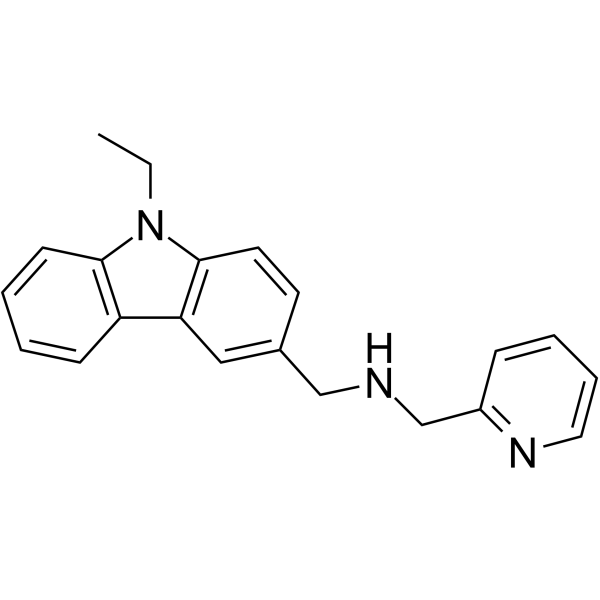
|
| DCC0970 | Bi-1750 Featured |
BI-1750 is a highly selective and stable fluorogenic substrate designed for Cathepsin C (CatC), a lysosomal cysteine protease involved in various physiological and pathological processes. Its unique properties make it a powerful tool for studying CatC activity in both research and drug development contexts.
More description
|

|
| DC60284 | GN13 Featured |
GN13 is a potent, selective, and cell-permeable inhibitor of Gαs, with a strong binding affinity for the active, GTP-bound state of Gαs (KD = 0.19 μM). Its high selectivity and ability to penetrate cells make it a powerful tool for studying Gαs signaling in both basic research and potential therapeutic applications.
More description
|
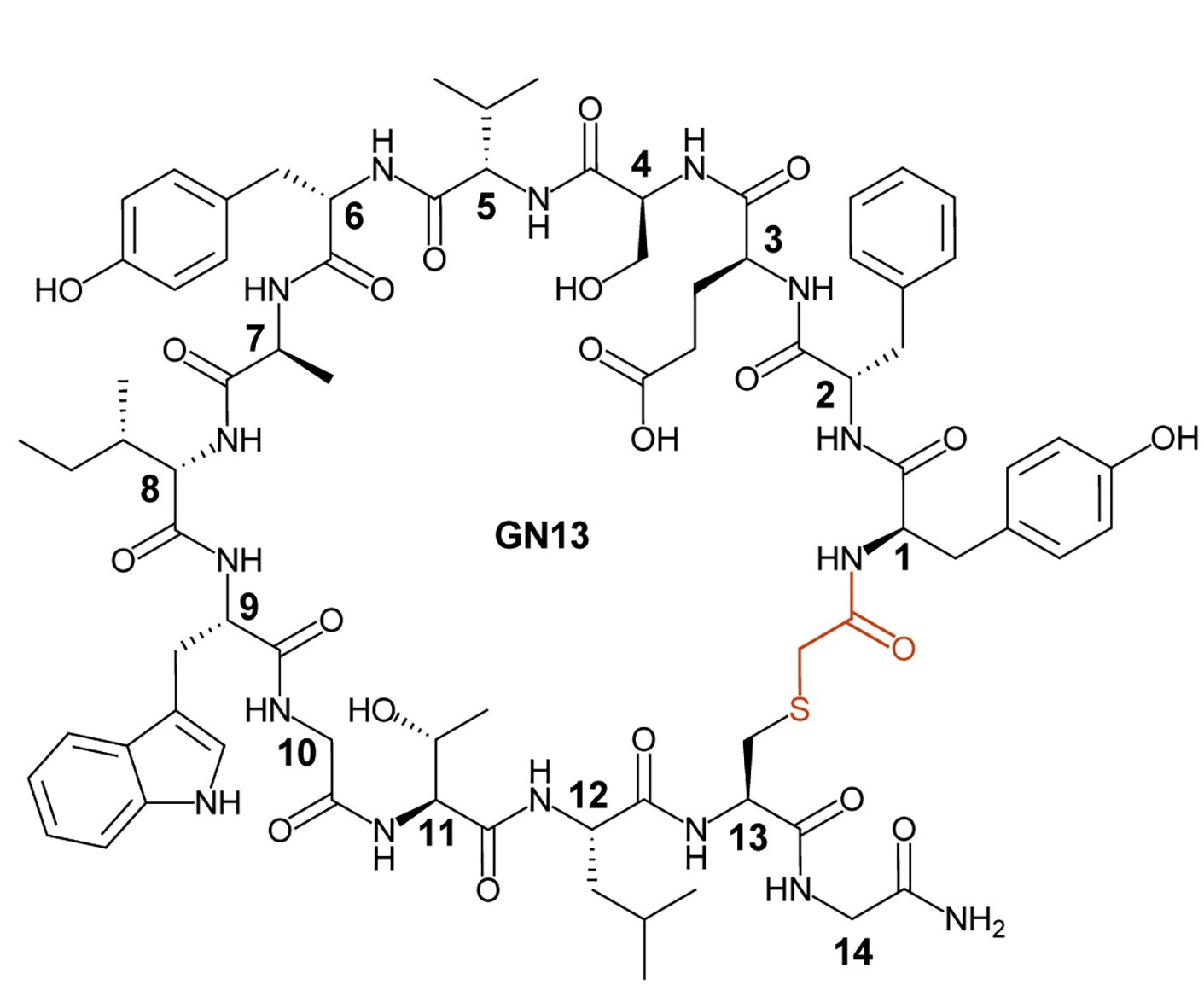
|
| DC43898 | CN009543V Featured |
The statement suggests that CN009543V enhances tyrosine phosphorylation of the epidermal growth factor receptor (EGFR) through downstream signaling pathways.
More description
|
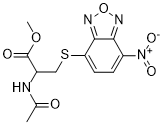
|
| DC73624 | FP802 Featured |
FP802 is a novel small molecule with significant neuroprotective properties, specifically designed to target and disrupt the TwinF interface within the NMDAR/TRPM4 death signaling complex. This unique mechanism allows FP802 to selectively eliminate extrasynaptic NMDAR (eNMDAR)-mediated toxicity, which is implicated in various neurodegenerative diseases, while preserving the essential physiological functions of synaptic NMDARs. This selectivity makes FP802 a promising therapeutic candidate for conditions involving excitotoxicity and neuronal cell death.
More description
|

|
| DCC3868 | Obtusaquinone Featured |
Obtusaquinone (OBT) is a potent antineoplastic agent with significant therapeutic potential, particularly in aggressive cancers such as glioblastoma and breast cancer. Its mechanism of action involves the induction of oxidative stress and endoplasmic reticulum (ER) stress, leading to cancer cell death. OBT has demonstrated promising in vivo activity, including the ability to penetrate the blood-brain barrier (BBB) and target brain tumors, making it a particularly valuable candidate for treating central nervous system (CNS) malignancies.
More description
|

|
| DC11175 | Dual DDR1 and DDR2 inhibitor 5n Featured |
Dual DDR1 and DDR2 inhibitor 5n is a highly potent and selective small molecule inhibitor targeting both Discoidin Domain Receptor 1 (DDR1) and Discoidin Domain Receptor 2 (DDR2). These receptors are receptor tyrosine kinases (RTKs) that play critical roles in cell proliferation, migration, and extracellular matrix (ECM) remodeling. Dysregulation of DDR1 and DDR2 has been implicated in various diseases, including cancer, fibrosis, and inflammation, making them attractive therapeutic targets.
More description
|

|
| DC74313 | PLIHZ Featured |
PLIHZ is a small molecule inhibitor that targets DNAJA1, a member of the heat shock protein 40 (Hsp40) family. Derived from the natural compound plumbagin, PLIHZ specifically binds to the J domain of DNAJA1, which is crucial for its co-chaperone activity with Hsp70. By inhibiting DNAJA1, PLIHZ effectively reduces the levels of DNAJA1 and several conformational mutant p53 (mutp53) proteins, which are often stabilized in cancer cells and contribute to tumorigenesis.
More description
|

|
| DC11129 | AMPK activator SC4 Featured |
AMPK activator SC4 is a highly specific and potent activator of the α2β2-AMPK complexes, which are the predominant AMPK isoform complexes found in human skeletal muscle. SC4 demonstrates significant efficacy with EC50 values of 17.2 nM for the α2β2γ1 complex and 82.1 nM for the α2β2γ3 complex. These low EC50 values indicate that SC4 is effective at relatively low concentrations, making it a promising compound for targeting AMPK in skeletal muscle. This specificity and potency suggest potential therapeutic applications in conditions where AMPK activation is beneficial, such as metabolic disorders, muscle function, and energy homeostasis.
More description
|

|
| DC21354 | MT47-100 Featured |
MT47-100 is a novel compound that exhibits a unique dual functionality as both an allosteric activator and inhibitor of AMP-activated protein kinase (AMPK) complexes, depending on the isoform present. Specifically, MT47-100 acts as a direct activator of AMPK complexes containing the β1 isoform and as a direct inhibitor of AMPK complexes containing the β2 isoform. This isoform-specific modulation of AMPK activity makes MT47-100 a potentially valuable tool for studying the distinct physiological roles of β1- and β2-containing AMPK complexes, as well as a candidate for therapeutic applications targeting AMPK-related pathways.
More description
|

|
| DC60219 | Camibirstat (FHD-286) Featured |
FHD-286 is a selective, oral inhibitor of SMARCA4/SMARCA2 ATPase (BRG1 and BRM) inhibitor. FHD-286 has the potential for the research of BAF (BRG1/BRM-associated factor)-related disorders such as acute myeloid leukemia.
More description
|
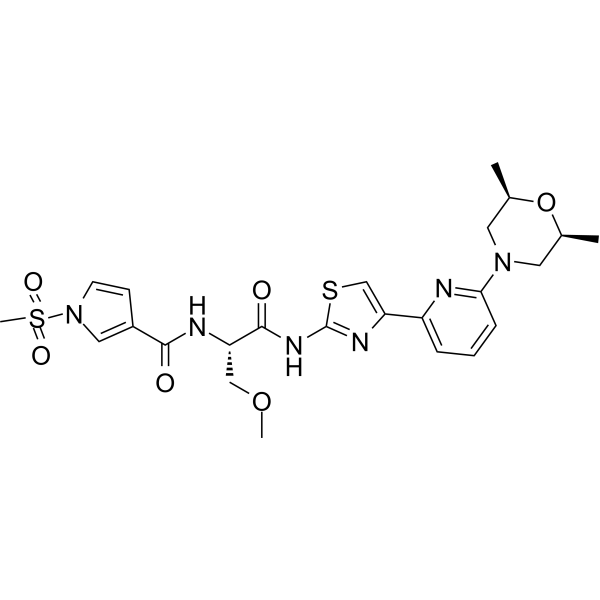
|
| DC21115 | TD-1 Featured |
Hemoglobin modulator TD-1 (TD-1) is a novel allosteric effector of hemoglobin that increases hemoglobin oxygen affinity and reduces SS erythrocyte sickling.
More description
|

|
| DC28134 | α-Galactosylceramide Featured |
α-Galactosylceramide (α-GalCer) is a synthetic glycolipid with antitumorial and immunostimulatory. α-Galactosylceramide is a very potent NKT cell agonist and binds effectively to CD1d. The complex of α-Galactosylceramide plus CD1d binds the NKT cell TCR (T cell antigen receptor).
More description
|
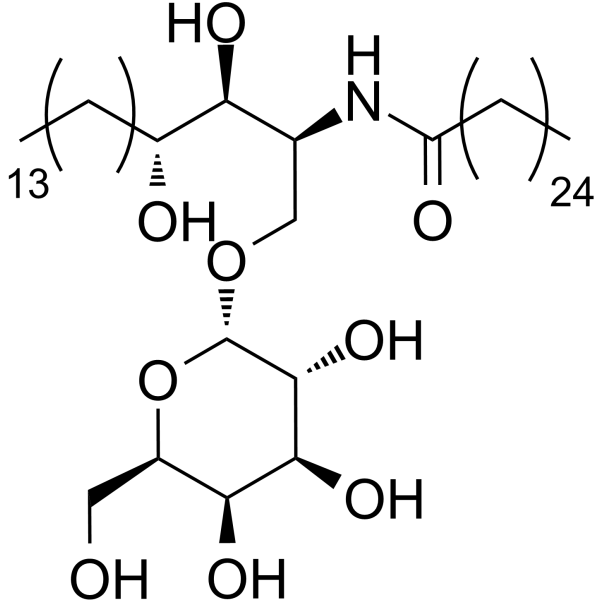
|
| DC73509 | S6821 Featured |
S6821 (S 6821) is a potent and selective antagonist of the bitter taste receptor TAS2R8, exhibiting an IC50 value of 21 nM.
It demonstrates high selectivity across a panel of 16 TAS2Rs, effectively reduces the bitterness of coffee, and shows an excellent safety profile.
More description
|

|
| DC20045 | GGsTop (Nahlsgen) Featured |
GGsTop (Nahlsgen) is a potent, non-toxic, highly selective and irreversible γ-GGT inhibitor, with a Ki of 170 μM for Human GGT. GGsTop shows a pKa of 9.71, also exhibits Kons of 150 and 51 M-1 s-1 against E.coli GGT and human GGT, respectively. GGsTop protects hepatic ischemia-reperfusion injury in rat model.
More description
|

|
| DC10304 | RA190 Featured |
RA190, a bis-benzylidine piperidon, inhibits proteasome function by covalently binding to cysteine 88 of ubiquitin receptor RPN13.
More description
|
|
| DC45758 | Revumenib Featured |
SNDX-5613 is a potent and selective inhibitor of menin-MLL binding with a Ki of 0.15 nM. SNDX-5613 shows anti-proliferative activity against multiple cell lines harboring MLLr translocations (MV4;11, RS4;11, MOLM-13, KOPN-8) with IC50 values ranging from 10-20 nM.
More description
|
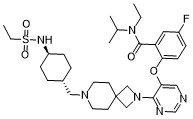
|
| DC73377 | AS408 Featured |
AS408 is a negative allosteric modulator of the β2-adrenergic receptor (β2AR) for both G-protein activation and arrestin recruitment (pKB=6.8, [35S]GTPγS binding assays), binds to a pocket formed by the membrane-facing surface of TM3 and TM5.
More description
|

|
| DC39113 | Gartisertib Featured |
Gartisertib (VX-803) is an ATP-competitive, orally active, and selective ATR inhibitor, with a Ki of <150 pM. Gartisertib potently inhibits ATR-driven phosphorylated checkpoint kinase-1 (Chk1) phosphorylation with an IC50 of 8 nM. Antitumor activity.
More description
|

|
| DC72634 | (Rac)-SNC80 |
(Rac)-SNC80 is a racemate of SNC80. SNC80 (NIH 10815) is a potent, highly selective and non-peptide δ-opioid receptor agonist with a Ki of 1.78 nM and an IC50 of 2.73 nM. SNC80 shows antinociceptive, antihyperalgesic and antidepressant‐like effects. SNC80 has the potential for multiple headache disorders treatment.
More description
|

|
| DC22902 | SNC-80 Featured |
SNC80 (NIH 10815) is a potent, highly selective and non-peptide δ-opioid receptor agonist with a Ki of 1.78 nM and an IC50 of 2.73 nM. SNC80 also selectively activates μ-δ heteromer in HEK293 cells with an EC50 of 52.8 nM. SNC80 shows antinociceptive, antihyperalgesic and antidepressant‐like effects. SNC80 has the potential for multiple headache disorders treatment.
More description
|
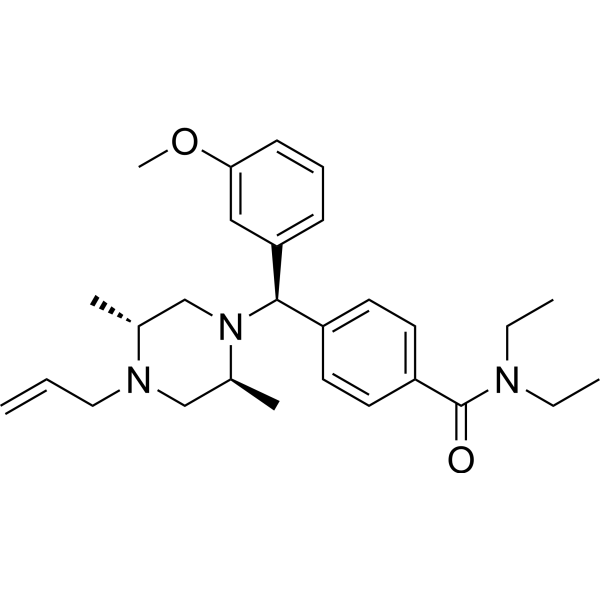
|
| DC43414 | PT1 Featured |
PT1 is an activator of AMP-activated protein kinase (AMPK) that directly activates the inactive truncated forms of AMPK monomers α1335, α1394, and α2398 in a dose-dependent manner (EC50s = ~ 8, 8, and 12 µM, respectively).
More description
|
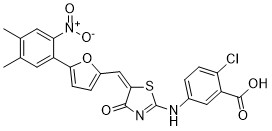
|
| DC41030 | 1,4-DPCA ethyl ester Featured |
1,4-DPCA ethyl ester is the ethyl ester of 1,4-DPCA and can inhibit factor inhibiting HIF (FIH).
More description
|

|
| DC43625 | Paprotrain Featured |
Reversible, non-ATP competitive inhibitor of mitotic kinesin-like protein 2 (MKLP-2)
More description
|

|
| DC10921 | ATH686 Featured |
ATH686 (ATH-686) is a potent and selective, second-generation inhibitor of mutant FLT3 protein kinase.
More description
|

|
| DC71536 | FABPs ligand 6 Featured |
FABPs ligand 6 (MF6) is an FABP5 and FABP7 inhibitor with KD values of 874 nM and 20 nM, respectively. FABPs ligand 6 can be used for multiple sclerosis research.
More description
|
.gif)
|
| DC7930 | EI-1 Featured |
EI1 is a potent and selective small molecule inhibitor of EZH2 with IC50 values of 15 nM and 13 nM for wild type EZH2 and EZH2 Y641F mutant, respectively.
More description
|
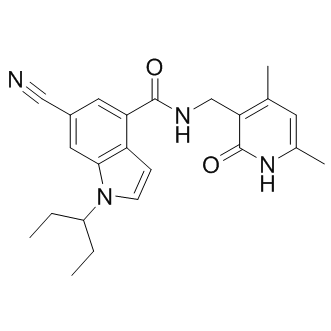
|
| DC11370 | TAK-901 Featured |
TAK-901 is a non-selective Aurora kinase inhibitor (IC50s = 3.1, 10, and 4.2 nM for Aurora A, B, and C, respectively).
More description
|

|